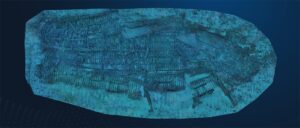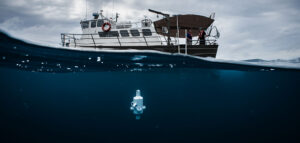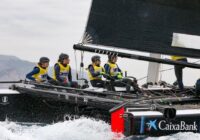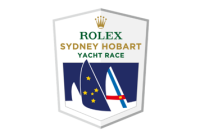Advanced Navigation, a global leader in AI robotics and navigation technology, is bringing humans closer to the ocean like never before – starting with a drone.
Hydrus, a revolution in underwater robotic technology, was recently sent to the treacherous depths of the Rottnest ship graveyard located in the Indian Ocean, just off the coast of Western Australia. Upon unloading its data, the team was ecstatic to discover Hydrus had spotted a 64-metre shipwreck scattered across the seafloor (more than twice the size of a blue whale – the largest marine animal).

Parting the Sea for Underwater Heritage
Unfathomably, only 5% of the ocean has been explored and charted by humans. Included in the mysterious 95% are 3 million undiscovered shipwrecks with 1,819 recorded wrecks currently lying off the shore of Western Australia. Each one holds a key to humanity’s understanding of past culture, history and science. Beginning in the 1900s, the Rottnest graveyard became a burial ground for ships, naval vessels, aircraft and secretive submarines. The majority of these wrecks have yet to be discovered due to their depths ranging from 50m to 200m. Sourcing data from this depth often requires specialised equipment and training, causing the mission to be overly expensive and challenging.

Revealing the Ocean’s Secrets
Small enough to be deployed by a single person, Hydrus utilised its advanced navigation and communication sensors to capture 4K video and imagery simultaneously. Upon returning to the surface, the team analysed the data and found Hydrus had examined a 64-metre shipwreck. Learning the exact coordinates of the ship, the team used two Hydrus units to perform three missions, completing the full survey in just under five hours. This level of efficiency is crucial for underwater exploration where costs can heighten quickly. The results were shared with the Western Australian Museum and Curtin University HIVE for further processing and historical analysis.
Peter Baker, Subsea Product Manager at Advanced Navigation, said,
“The ocean is an incredibly difficult terrain to work in. Underwater inspections are prohibitively expensive, running into the millions. They require large vessels, complex machinery, qualified crew and put divers at risk. This has made it logistically complex, cost-prohibitive and inflexible to learn about the relics of the underwater world.
The successful and high-resolution portrait of this particular shipwreck testifies the powerful capabilities of underwater drones such as Hydrus. For this particular mission, Hydrus was able to lower the operational cost by 75% compared to traditional methods.
We’ve seen a revolution take place in the aerial drone industry. 10-15 years ago, only qualified experts could fly drones. Today, drones are simple and reliable enough for anyone to use. That revolution is now taking off in the underwater world, where advanced technologies are making it easier than ever to open up the oceans and make knowledge more accessible to everyone.
We will continue exploring the Indian Ocean with Hydrus in the hopes of discovering more of the world’s best kept secrets.”
Creating a Digital Copy of the Ocean
Specialising in shipwreck photogrammetry, Curtin University HIVE was able to rebuild a high-resolution replica of the wreck, using the data gathered by Hydrus. This involved taking 4K geo-referenced imagery and video footage from Hydrus to generate a 3D digital twin of the shipwreck.
Associate Professor Andrew Woods, at the Curtin University HIVE said, “The inclusion of navigational coordinates for geolocation is a fantastic feature of Hydrus. It can’t be overstated how much this structure in data assists with constraining feature matching and reducing the processing time, especially in larger datasets.”
Western Australia is a destination for sunken history
Upon examination by Dr. Ross Anderson, Curator at the WA Museum, the historical significance behind the wreck was unveiled as a 100+-year-old coal hulk from Fremantle Port’s bygone days. Historically, these old iron ships were workhorses used to service steamships in Western Australia. Most of the fifteen old iron and wooden ships recorded in the shipwreck graveyard were built as fast clipper ships to ply the lucrative grain and wool trades between the UK and Australia, built in the 1860-80s and scuttled around the 1920s-30s. They now lie dormant, waiting to be explored.
Dr. Ross Anderson shared, “This is the clearest and most comprehensive data set the WA Museum has received from this particular wreck. This type of high-resolution imagery is invaluable for maritime archaeological research and education on underwater cultural heritage. With tools like Hydrus, we can obtain accurate maps and 3D models of deepwater historic shipwrecks and learn more about untold stories beneath the waves.”
The data has been shared with the WA Museum for their public archives and can be seen in lifesize form at the Curtin University HIVE on their immersive Cylinder display. The teams now have their sights set on uncovering more mysteries, like those of the luxurious SS Koombana – an ultra-luxury passenger ship ferrying more than 150 passengers before it vanished into the swirling wrath of a cyclone in 1912. The teams plan to continue exploring the Indian Ocean with Hydrus in the hopes of discovering more of the world’s best kept secrets.
Lowering the cost of underwater data collection
Gathering ocean data has traditionally been risky and costly. Sending a human diver or remotely operated vehicle (ROV) down to less than 50m deep comes in at around AUD$20,000, with depths more than 50m costing to upwards of AUD$100,000.
Hydrus, however, is turning the tide in ocean exploration costs. In this particular mission, Hydrus was able to reduce the surveying cost by up to 75%, enabling the team to conduct more frequent and extensive surveying of the wreck in a shorter time period. Its compact design (weighing around 7kg) eliminates the need for large vessels, complex launch systems and professional dive teams.
Discover how Hydrus brings affordable insights to the surface.








